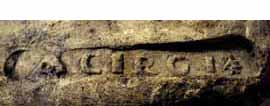- Glass Making in Roman Times
- Roman Wine: A Window on an Ancient Economy
- Roman Wine: Windows on a Lifestyle
- Fine Glassware in the Roman World
- Reuse of Images in the Art of Rogier van der Weyden
The Growth of Estates

Impression L.Q.S.
Spanish vintner, Lucius Quintus Secundus
Hadrian's Wall, circa A.D. 80-130

Impression ACIRGI
Major vintner in southern Spain
circa A.D. 90-140
The kind of cost-effective organization of estate activities that developed around Cosa in Republican times were by no means unique. Amphorae bearing estate-markings of one of Julius Caesar's business associates, Rabirius Postumus, have been found Germany and Sicily. Those of Cicero's friend, Marcus Tuccius Galeo, whose estate was near Brundisium, have been recovered from the Planier shipwreck, offshore from Marseilles. And, during the latter part of the 1st century A.D., when landowners of southern Spain came to dominate trade in the western Empire not just of wine but of olive oil and garum as well, their estates often would include an amphora-making pottery among its facilities.
During the early imperial era, the estate production of amphorae will have been mixed in with that of domestic vessels, bricks, and tiles. Most of these latter items will have been used on the estate itself, though surpluses may have found their way to the local marketplace. Some well-established potteries, such as the figlina Acirgiana, extended their business by providing amphorae to the newly settling neighbors.
